Effects of Excessive Equatorial Cold Tongue Bias on the Projections of Tropical Pacific Climate Change. Part II: The Extreme El Niño Frequency in CMIP5 Multi-Model Ensemble
Abstract
1. Introduction
2. Models, Datasets, and Methods
2.1. Models
2.2. Datasets
2.3. Definition of Extreme El Niño Events
2.4. Correction Method of the Future Projections
3. Results
3.1. Extreme El Niño Occurrences vs. El Niño-Like Warming Pattern
3.2. Effect of the Cold Tongue Bias on El Niño-Like Warming Pattern
3.3. Effect of the Excessive Pacific Cold Tongue Error on Extreme El Niño Occurrences
3.4. Uncorrected vs. Corrected WNP Precipitation Changes
4. Conclusions
5. Discussion
Author Contributions
Funding
Institutional Review Board Statement
Informed Consent Statement
Data Availability Statement
Acknowledgments
Conflicts of Interest
References
- Bjerknes, J. Atmospheric teleconnections from the equatorial Pacific. Mon. Weather. Rev. 1969, 97, 163–172. [Google Scholar] [CrossRef]
- Rasmusson, E.; Carpenter, T. Variations in tropical sea surface temperature and surface wind fields associated with the Southern Oscillation/El Niño. Mon. Weather Rev. 1982, 110, 354–384. [Google Scholar] [CrossRef]
- Zebiak, S.E.; Cane, M.A. A model El Niño–Southern Oscillation. Mon. Weather Rev. 1987, 115, 2262–2278. [Google Scholar] [CrossRef]
- Suarez, M.J.; Schopf, P.S. A delayed action oscillator for ENSO. J. Atmos. Sci. 1988, 45, 3283–3287. [Google Scholar] [CrossRef]
- Lau, N.C.; Nath, M.J. The role of the “atmospheric bridge” in linking tropical Pacific ENSO events to extratropical SST anomalies. J. Clim. 1996, 9, 2036–2057. [Google Scholar] [CrossRef]
- Jin, F.F. An equatorial recharge paradigm for ENSO. Part I: Conceptual model. J. Atmos. Sci. 1997, 54, 811–829. [Google Scholar] [CrossRef]
- Dai, A.; Wigley, T.M.L. Global patterns of ENSO-induced precipitation. Geophys. Res. Lett. 2000, 27, 1283–1286. [Google Scholar] [CrossRef]
- McPhaden, M.J.; Zebiak, S.E.; Glantz, M.H. ENSO as an integrating concept in earth science. Science 2006, 314, 1739–1745. [Google Scholar] [CrossRef]
- Guilyardi, E.; Wittenberg, A.; Fedorov, A.; Collins, M.; Wang, C.Z.; Capotondi, A.; van Oldenborgh, G.J.; Stockdale, T. Understanding El Niño in ocean-atmosphere general circulation models: Progress and challenges. Bull. Am. Meteorol. Soc. 2009, 90, 325–340. [Google Scholar] [CrossRef]
- Cai, W.; Santoso, A.; Wang, G.; Yeh, S.-W.; An, S.-I.; Cobb, K.M.; Collins, M.; Guilyardi, E.; Jin, F.-F.; Kug, J.-S.; et al. Increasing frequency of extreme El Niño events due to greenhouse warming. Nat. Clim. Chang. 2014, 4, 111–116. [Google Scholar] [CrossRef]
- Li, G.; Xie, S.-P.; He, C.; Chen, Z. Western Pacific emergent constraint lowers projected increase in Indian summer monsoon rainfall. Nat. Clim. Chang. 2017, 7, 708–712. [Google Scholar] [CrossRef]
- Wu, R.; Chen, J.; Chen, W. Different types of ENSO influences on the Indian summer monsoon variability. J. Clim. 2012, 25, 903–920. [Google Scholar] [CrossRef]
- Webster, P.J.; Yang, S. Monsoon and ENSO: Selectively interactive systems. Q. J. R. Meteorol. Soc. 1992, 118, 877–926. [Google Scholar] [CrossRef]
- Wang, Z.; Li, G.; Yang, S. Origin of Indian summer monsoon rainfall biases in CMIP5 multimodel ensemble. Clim. Dyn. 2018, 51, 755–768. [Google Scholar] [CrossRef]
- Kumar, K.K.; Rajagopalan, B.; Cane, M.A. On the weakening relationship between the Indian monsoon and ENSO. Science 1999, 284, 2156–2159. [Google Scholar] [CrossRef] [PubMed]
- Zou, Y.; Yu, J.-Y.; Lee, T.; Lu, M.-M.; Kim, S.T. CMIP5 model simulations of the impacts of the two types of El Niño on the U.S. winter temperature. J. Geophys. Res. Atmos. 2014, 119, 3076–3092. [Google Scholar] [CrossRef]
- Larkin, N.K.; Harrison, D.E. On the definition of El Niño and associated seasonal average US weather anomalies. Geophys. Res. Lett. 2005, 32, L13705. [Google Scholar] [CrossRef]
- Ropelewski, C.F.; Halpert, M.S. North American precipitation and temperature patterns associated with the El Niño/Southern Oscillation (ENSO). Mon. Weather Rev. 1986, 114, 2352–2362. [Google Scholar] [CrossRef]
- Li, G.; Jian, Y.; Yang, S.; Du, Y.; Wang, Z.; Li, Z.; Zhuang, W.; Jiang, W.; Huang, G. Effect of excessive equatorial Pacific cold tongue bias on the El Niño-Northwest Pacific summer monsoon relationship in CMIP5 multi-model ensemble. Clim. Dyn. 2019, 52, 6195–6212. [Google Scholar] [CrossRef]
- Yang, C.; Ren, B.; Li, G.; Zheng, J. Change of the wintertime SSTA variability over the West Pacific after the mid-1980s: Effect of the increasing El Niño Modoki. J. Geophys. Res. Atmos. 2014, 119, 5204–5225. [Google Scholar] [CrossRef]
- Zhou, L.-T.; Wu, R. Respective impacts of the East Asian winter monsoon and ENSO on winter rainfall in China. J. Geophys. Res. 2010, 115, D02107. [Google Scholar] [CrossRef]
- Wang, B.; Wu, R.; Fu, X. Pacific-East Asian teleconnection: How does ENSO affect East Asian climate? J. Clim. 2000, 13, 1517–1536. [Google Scholar] [CrossRef]
- Teng, H.F.; Lee, C.-S.; Hsu, H.-H. Influence of ENSO on formation of tropical cloud clusters and their development into tropical cyclones in the western North Pacific. Geophys. Res. Lett. 2014, 41, 9120–9126. [Google Scholar] [CrossRef]
- Camargo, S.J.; Emanuel, K.A.; Sobel, A.H. Use of a genesis potential index to diagnose ENSO effects on tropical cyclone genesis. J. Clim. 2007, 20, 4819–4834. [Google Scholar] [CrossRef]
- Camargo, S.J.; Sobel, A.H. Western North Pacific tropical cyclone intensity and ENSO. J. Clim. 2005, 18, 2996–3006. [Google Scholar] [CrossRef]
- Wang, B.; Chan, J.C.L. How strong ENSO events affect tropical storm activity over the Western North Pacific. J. Clim. 2002, 15, 1643–1658. [Google Scholar] [CrossRef]
- Banholzer, S.; Donner, S. The influence of different El Niño types on global average temperature. Geophys. Res. Lett. 2014, 41, 2093–2099. [Google Scholar] [CrossRef]
- Larkin, N.K.; Harrison, D.E. Global seasonal temperature and precipitation anomalies during El Niño autumn and winter. Geophys. Res. Lett. 2005, 32, L16705. [Google Scholar] [CrossRef]
- Yulaeva, E.; Wallace, J.M. The signature of ENSO in global temperature and precipitation fields derived from the microwave sounding unit. J. Clim. 1994, 7, 1719–1736. [Google Scholar] [CrossRef]
- Alexander, M.A.; Bladé, I.; Newman, M.; Lanzante, J.R.; Lau, N.-C.; Scott, J.D. The atmospheric bridge: The influence of ENSO teleconnections on air-sea interaction over the global oceans. J. Clim. 2002, 15, 2205–2231. [Google Scholar] [CrossRef]
- Kiladis, G.N.; Diaz, H.F. Global climatic anomalies associated with extremes in the Southern Oscillation. J. Clim. 1989, 2, 1069–1090. [Google Scholar] [CrossRef]
- Trenberth, K.E.; Caron, J.M. The Southern Oscillation revisited: Sea level pressures, surface temperatures, and precipitation. J. Clim. 2000, 13, 4358–4365. [Google Scholar] [CrossRef]
- Ropelewski, C.F.; Halpert, M.S. Global and regional scale precipitation patterns associated with the El Niño/Southern Oscillation. Mon. Weather Rev. 1987, 115, 1606–1626. [Google Scholar] [CrossRef]
- Klein, T.A.; Soden, B.J.; Lau, N.-C. Remote sea surface temperature variations during ENSO: Evidence for a tropical atmospheric bridge. J. Clim. 1999, 12, 917–932. [Google Scholar] [CrossRef]
- Philander, S.G.H. Anomalous El Niño of 1982–83. Nature 1983, 305, 16. [Google Scholar] [CrossRef]
- McPhaden, M.J. El Niño: The child prodigy of 1997–98. Nature 1999, 398, 559–562. [Google Scholar] [CrossRef]
- Hoerling, M.P.; Kumar, A. Origins of extreme climate states during the 1982–83 ENSO winter. J. Clim. 1997, 10, 2859–2870. [Google Scholar] [CrossRef]
- Cai, W.; Santoso, A.; Wang, G.; Yeh, S.-W.; An, S.-I.; Cobb, K.M.; Collins, M.; Guilyardi, E.; Jin, F.-F.; Kug, J.-S.; et al. ENSO and greenhouse warming. Nat. Clim. Chang. 2015, 5, 849–859. [Google Scholar] [CrossRef]
- Page, S.E.; Siegert, F.; Rieley, J.O.; Boehm, H.-D.V.; Jaya, A.; Limin, S. The amount of carbon released from peat and forest fires in Indonesia in 1997. Nature 2002, 420, 61–65. [Google Scholar] [CrossRef]
- Emmanuel, S. Impact to lung health of haze from forest fires: The Singapore experience. Respirology 2000, 5, 175–182. [Google Scholar] [CrossRef]
- Frankenberg, E.; McKee, D.; Thomas, D. Health consequences of forest fires in Indonesia. Demography 2005, 42, 109–129. [Google Scholar] [CrossRef]
- Merlen, G. The 1982–1983 El Niño: Some of its consequences for Galapagos wildlife. Oryx 1984, 18, 210–214. [Google Scholar] [CrossRef]
- Valle, C.A.; Cruz, F.; Cruz, J.B.; Merlen, G.; Coulter, M.C. The impact of the 1982–1983 El Niño-Southern Oscillation on seabirds in the Galapagos Islands, Ecuador. J. Geophys. Res. 1987, 92, 14437–14444. [Google Scholar] [CrossRef]
- Tokinaga, H.; Xie, S.-P.; Timmermann, A.; McGregor, S.; Ogata, T.; Kubota, H.; Okumura, Y.M. Regional patterns of tropical Indo-Pacific climate change: Evidence of the Walker Circulation weakening. J. Clim. 2012, 25, 1689–1710. [Google Scholar] [CrossRef]
- Domingues, C.M.; Church, J.A.; White, N.J.; Gleckler, P.J.; Wijffels, S.E.; Barker, P.M.; Dunn, J.R. Improved estimates of upper-ocean warming and multi-decadal sea-level rise. Nature 2008, 453, 1090–1093. [Google Scholar] [CrossRef] [PubMed]
- Kaplan, A.; Cane, M.A.; Kushnir, Y.; Clement, A.C.; Blumenthal, M.B.; Rajagopalan, B. Analyses of global sea surface temperature 1856–1991. J. Geophys. Res. 1998, 103, 18567–18589. [Google Scholar] [CrossRef]
- Deser, C.; Phillips, A.; Alexander, M. Twentieth century tropical sea surface temperature trends revisited. Geophys. Res. Lett. 2010, 37, L10701. [Google Scholar] [CrossRef]
- Hansen, J.; Sato, M.; Ruedy, R.; Lo, K.; Lea, D.W.; Medina-Elizade, M. Global temperature change. Proc. Natl. Acad. Sci. USA 2006, 103, 14288–14293. [Google Scholar] [CrossRef] [PubMed]
- Cane, M.A.; Clement, A.C.; Kaplan, A.; Kushnir, Y.; Pozdnyakov, D.; Seager, R.; Zebiak, S.; Murtugudde, R. Twentieth century sea surface temperature trends. Science 1997, 275, 957–960. [Google Scholar] [CrossRef] [PubMed]
- Taylor, K.E.; Stouffer, R.J.; Meehl, G.A. An overview of CMIP5 and the experimental design. Bull. Am. Meteorol. Soc. 2012, 93, 485–498. [Google Scholar] [CrossRef]
- Meehl, G.A.; Covey, C.; Delworth, T.; Latif, M.; McAvaney, B.; Mitchell, F.B.; Stouffer, R.J.; Taylor, K.E. The WCRP CMIP3 multimodel dataset: A new era in climate change research. Bull. Am. Meteorol. Soc. 2007, 88, 1383–1394. [Google Scholar] [CrossRef]
- Tokinaga, H.; Xie, S.-P.; Deser, C.; Kosaka, Y.; Okumura, Y.M. Slowdown of the Walker circulation driven by tropical Indo-Pacific warming. Nature 2012, 491, 439–443. [Google Scholar] [CrossRef]
- Knutson, T.R.; Manabe, S. Time-mean response over the tropical Pacific due to increased CO2 in a coupled ocean-atmosphere model. J. Clim. 1995, 8, 2181–2199. [Google Scholar] [CrossRef]
- Vecchi, G.A.; Soden, B.J. Global warming and the weakening of the tropical circulation. J. Clim. 2007, 20, 4316–4340. [Google Scholar] [CrossRef]
- Meehl, G.A.; Washington, W.M. El Niño-like climate change in a model with increased atmospheric CO2 concentrations. Nature 1996, 382, 56–60. [Google Scholar] [CrossRef]
- Xie, S.-P.; Deser, C.; Vecchi, G.A.; Ma, J.; Teng, H.; Wittenberg, A.T. Global warming pattern formation: Sea surface temperature and rainfall. J. Clim. 2010, 23, 966–986. [Google Scholar] [CrossRef]
- Lloyd, J.; Guilyardi, E.; Weller, H. The role of atmosphere feedbacks during ENSO in the CMIP3 models. Part II: Using AMIP runs to understand the heat flux feedback mechanisms. Clim. Dyn. 2011, 37, 1271–1292. [Google Scholar] [CrossRef]
- Bony, S.; Lau, K.-M.; Sud, Y.C. Sea surface temperature and large scale circulation influences on tropical greenhouse effect and cloud radiative forcing. J. Clim. 1997, 10, 2055–2077. [Google Scholar] [CrossRef]
- Ramanathan, V.; Collins, W. Thermodynamic regulation of ocean warming by cirrus clouds deduced from observations of the 1987 El Niño. Nature 1991, 351, 27–32. [Google Scholar] [CrossRef]
- Li, G.; Xie, S.-P. Tropical biases in CMIP5 multimodel ensemble: The excessive equatorial Pacific cold tongue and double ITCZ problems. J. Clim. 2014, 27, 1765–1780. [Google Scholar] [CrossRef]
- Ma, C.-C.; Mechoso, C.R.; Robertson, A.W.; Arakawa, A. Peruvian stratus clouds and the tropical Pacific circulation: A coupled ocean-atmosphere GCM study. J. Clim. 1996, 9, 1635–1645. [Google Scholar] [CrossRef]
- Lloyd, J.; Guilyardi, E.; Weller, H. The role of atmosphere feedbacks during ENSO in the CMIP3 Models. Part III: The shortwave flux feedback. J. Clim. 2012, 25, 4275–4293. [Google Scholar] [CrossRef]
- Philander, S.G.H.; Gu, D.; Lambert, G.; Li, T.; Halpern, D.; Lau, N.-C.; Pacanowski, R. Why the ITCZ is mostly north of the equator. J. Clim. 1996, 9, 2958–2972. [Google Scholar] [CrossRef]
- Gordon, C.T.; Rosati, A.; Gudgel, R. Tropical sensitivity of a coupled model to specified ISCCP low clouds. J. Clim. 2000, 13, 2239–2260. [Google Scholar] [CrossRef][Green Version]
- Li, G.; Du, Y.; Xu, H.; Ren, B. An intermodel approach to identify the source of excessive equatorial Pacific cold tongue in CMIP5 models and uncertainty in observational datasets. J. Clim. 2015, 28, 7630–7640. [Google Scholar] [CrossRef]
- Zheng, Y.; Lin, J.-L.; Shinoda, T. The equatorial Pacific cold tongue simulated by IPCC AR4 coupled GCMs: Upper ocean heat budget and feedback analysis. J. Geophys. Res. 2012, 117, C05024. [Google Scholar] [CrossRef]
- Davey, M.K.; Huddleston, M.; Sperber, K.R.; Braconnot, P.; Bryan, F.; Chen, D.; Colman, R.A.; Cooper, C.; Cubasch, U.; Delecluse, P. STOIC: A study of coupled model climatology and variability in tropical ocean regions. Clim. Dyn. 2002, 18, 403–420. [Google Scholar]
- Yu, J.-Y.; Mechoso, C.R. Links between annual variations of Peruvian stratocumulus clouds and of SST in the eastern equatorial Pacific. J. Clim. 1999, 12, 3305–3318. [Google Scholar] [CrossRef]
- Mechoso, C.R.; Robertson, A.W.; Barth, N.; Davery, M.K.; Delecluse, P.; Gent, P.R.; Ineson, S.; Kirtman, B.; Latif, M.; Treut, H.L.; et al. The seasonal cycle over the tropical Pacific in coupled ocean-atmosphere general circulation models. Mon. Weather Rev. 1995, 123, 2825–2838. [Google Scholar] [CrossRef]
- Li, G.; Xie, S.-P.; Du, Y.; Luo, Y. Effects of excessive equatorial cold tongue bias on the projections of tropical Pacific climate change. Part I: The warming pattern in CMIP5 multi-model ensemble. Clim. Dyn. 2016, 47, 3817–3831. [Google Scholar] [CrossRef]
- Milinksi, S.; Maher, N.; Olonscheck, D. How large does a large ensemble need to be? Earth Syst. Dyn. 2020, 11, 885–901. [Google Scholar]
- Dee, D.P.; Uppala, S.M.; Simmons, A.J.; Berrisford, P.; Poli, P.; Kobayashi, S.; Andrae, U.; Balmaseda, M.A.; Balsamo, G.; Bauer, P.; et al. The ERA-Interim reanalysis: Configuration and performance of the data assimilation system. Q. J. R. Meteorol. Soc. 2011, 137, 553–597. [Google Scholar] [CrossRef]
- Adler, R.F.; Huffman, G.J.; Chang, A.; Ferraro, R.; Xie, P.-P.; Janowiak, J.; Rudolf, B.; Schneider, U.; Curtis, S.; Bolvin, D.; et al. The version 2 global precipitation climatology project (GPCP) monthly precipitation analysis (1979–present). J. Hydrometeorol. 2003, 4, 1147–1167. [Google Scholar] [CrossRef]
- Rayner, N.A.; Parker, D.E.; Horton, E.B.; Folland, C.K.; Alexander, L.V.; Rowell, D.P.; Kent, E.C.; Kaplan, A. Global analyses of sea surface temperature, sea ice, and night marine air temperature since the late nineteenth century. J. Geophys. Res. 2003, 108, 4407. [Google Scholar] [CrossRef]
- Lengaigne, M.; Vecchi, G.A. Contrasting the termination of moderate and extreme El Niño events in coupled general circulation models. Clim. Dyn. 2010, 35, 299–313. [Google Scholar] [CrossRef]
- Chiodi, A.M.; Harrison, D.E. Characterizing warm-ENSO variability in the equatorial Pacific: An OLR perspective. J. Clim. 2010, 23, 2428–2439. [Google Scholar] [CrossRef]
- Boe, J.; Hall, A.; Qu, X. September sea-ice cover in the Arctic ocean projected to vanish by 2100. Nat. Geosci. 2009, 2, 341–343. [Google Scholar] [CrossRef]
- Huang, P.; Ying, J. A multimodel ensemble pattern regression method to correct the tropical Pacific SST change patterns under global warming. J. Clim. 2015, 28, 4706–4723. [Google Scholar] [CrossRef]
- Cox, P.M.; Pearson, D.; Booth, B.B.; Friedlingstein, P.; Huntingford, C.; Jones, C.D.; Luke, C.M. Sensitivity of tropical carbon to climate change constrained by carbon dioxide variability. Nature 2013, 494, 341–344. [Google Scholar] [CrossRef]
- Bracegirdle, T.J.; Stephenson, D.B. On the robustness of emergent constraints used in multimodel climate change projections of Arctic warming. J. Clim. 2013, 26, 669–678. [Google Scholar] [CrossRef]
- Collins, M.; Chandler, R.E.; Cox, P.M.; Huthnance, J.M.; Rougier, J.; Stephenson, D.B. Quantifying future climate change. Nat. Clim. Chang. 2012, 2, 403–409. [Google Scholar] [CrossRef]
- Nitta, T. Convective activities in the tropical western Pacific and their impacts on the Northern Hemisphere summer circulation. J. Meteorol. Soc. Jpn. 1987, 65, 373–390. [Google Scholar] [CrossRef]
- Huang, R.; Lu, L. Numerical simulation of the relationship between the anomaly of subtropical high in East Asia and the convective activities in the tropical western Pacific. Adv. Atmos. Sci. 1989, 6, 202–214. [Google Scholar]
- Xie, S.-P.; Hu, K.; Hafner, J.; Tokinaga, H.; Du, Y.; Huang, G.; Sampe, T. Indian Ocean capacitor effect on Indo-Western Pacific climate during the summer following El Niño. J. Clim. 2009, 22, 730–747. [Google Scholar] [CrossRef]
- Yang, J.; Liu, Q.; Xie, S.-P.; Liu, Z.; Wu, L. Impact of the Indian Ocean SST basin mode on the Asian summer monsoon. Geophys. Res. Lett. 2007, 34, L02708. [Google Scholar] [CrossRef]
- Huang, R.-H.; Wu, Y.-F. The influence of ENSO on the summer climate change in China and its mechanism. Adv. Atmos. Sci. 1989, 6, 21–32. [Google Scholar]
- Hwang, Y.-T.; Frierson, D.M.M. Link between the double-Intertropical Convergence Zone problem and cloud biases over the Southern Ocean. Proc. Natl. Acad. Sci. USA 2013, 110, 4935–4940. [Google Scholar] [CrossRef]
- DiNezio, P.N.; Clement, A.C.; Vecchi, G.A.; Soden, B.J.; Kirtman, B.P.; Lee, S.-K. Climate response of the equatorial Pacific to global warming. J. Clim. 2009, 22, 4873–4892. [Google Scholar] [CrossRef]
- Zhou, Z.-Q.; Xie, S.-P. Effects of climatological model biases on the projection of tropical climate change. J. Clim. 2015, 28, 9909–9917. [Google Scholar] [CrossRef]
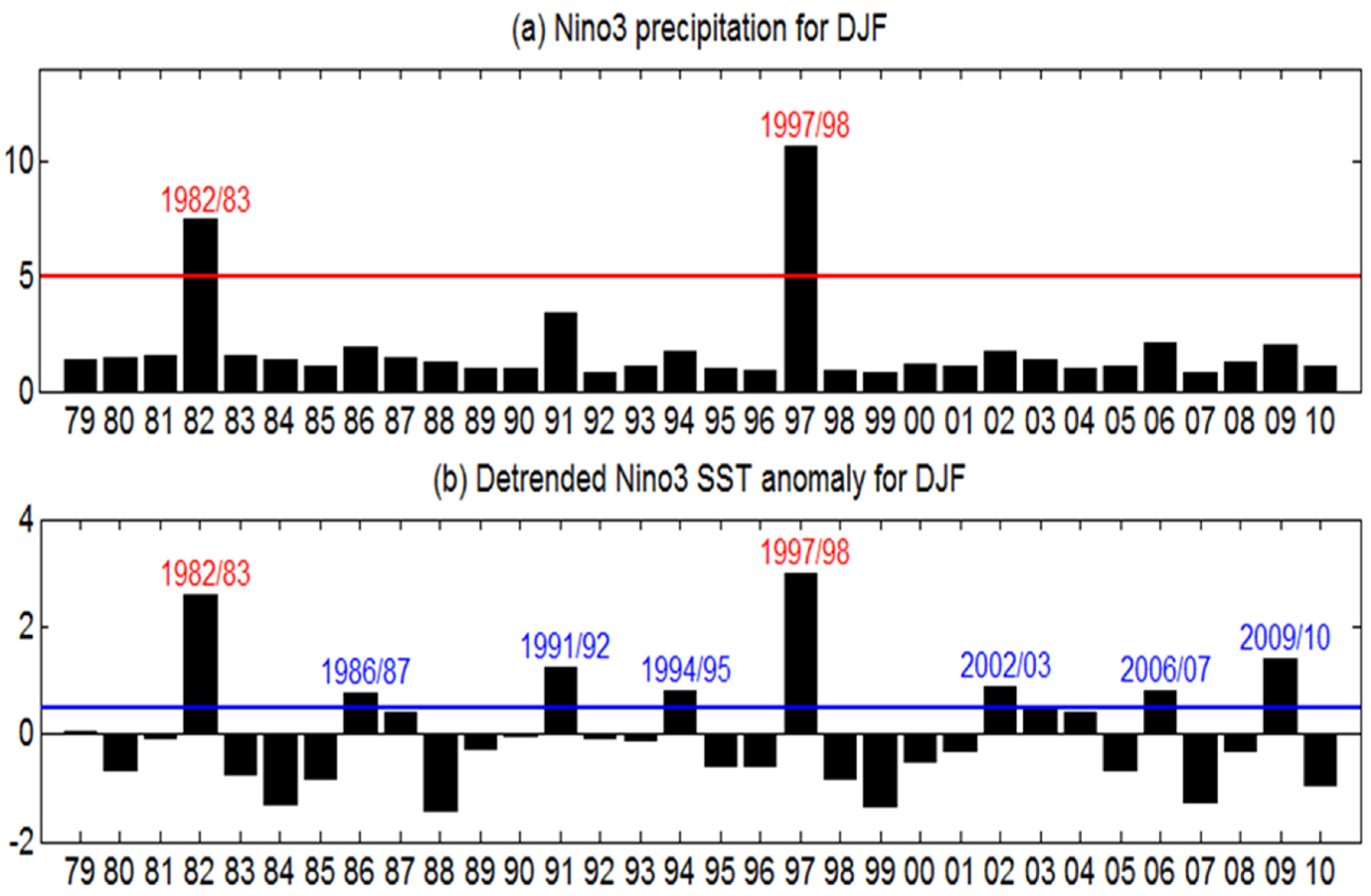
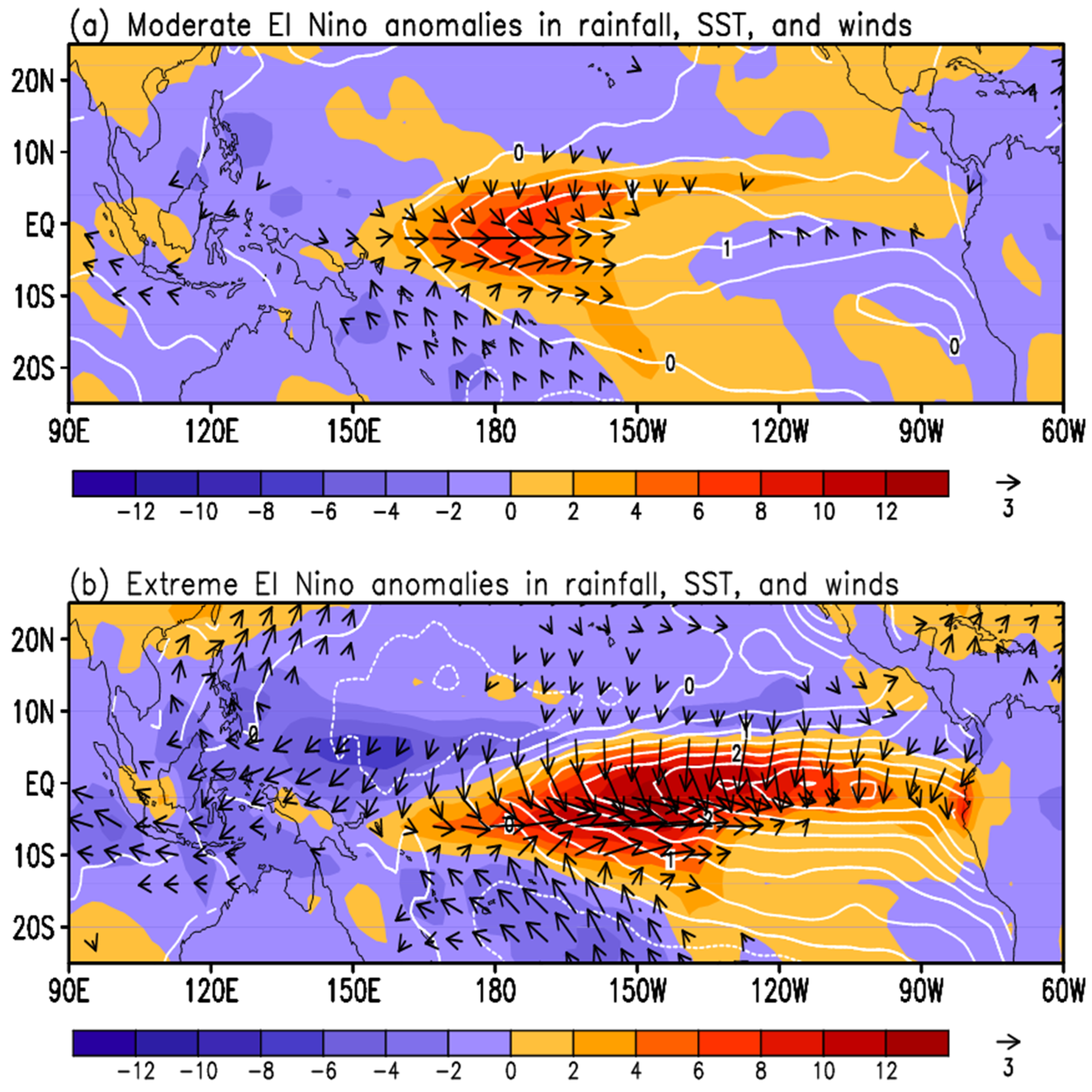
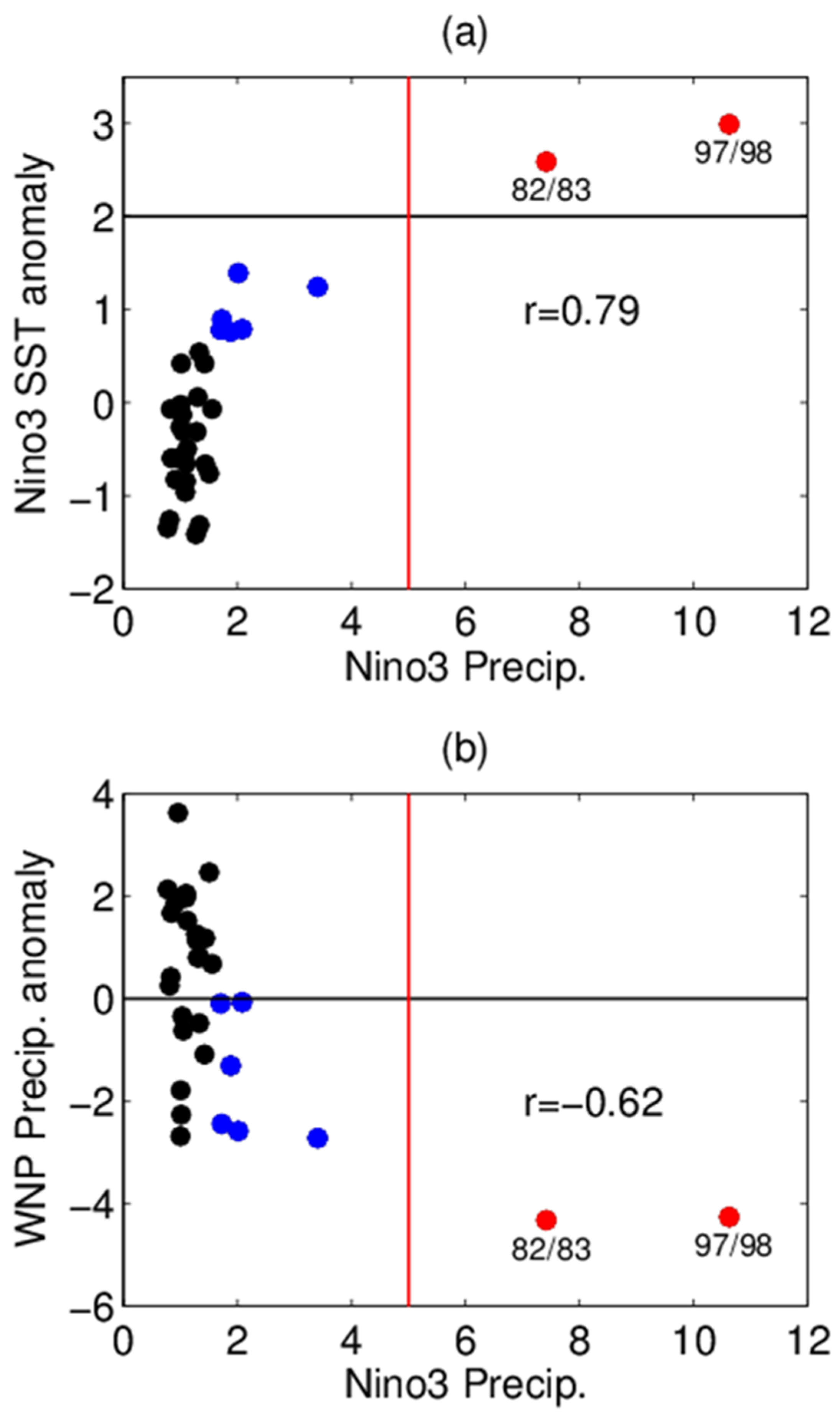
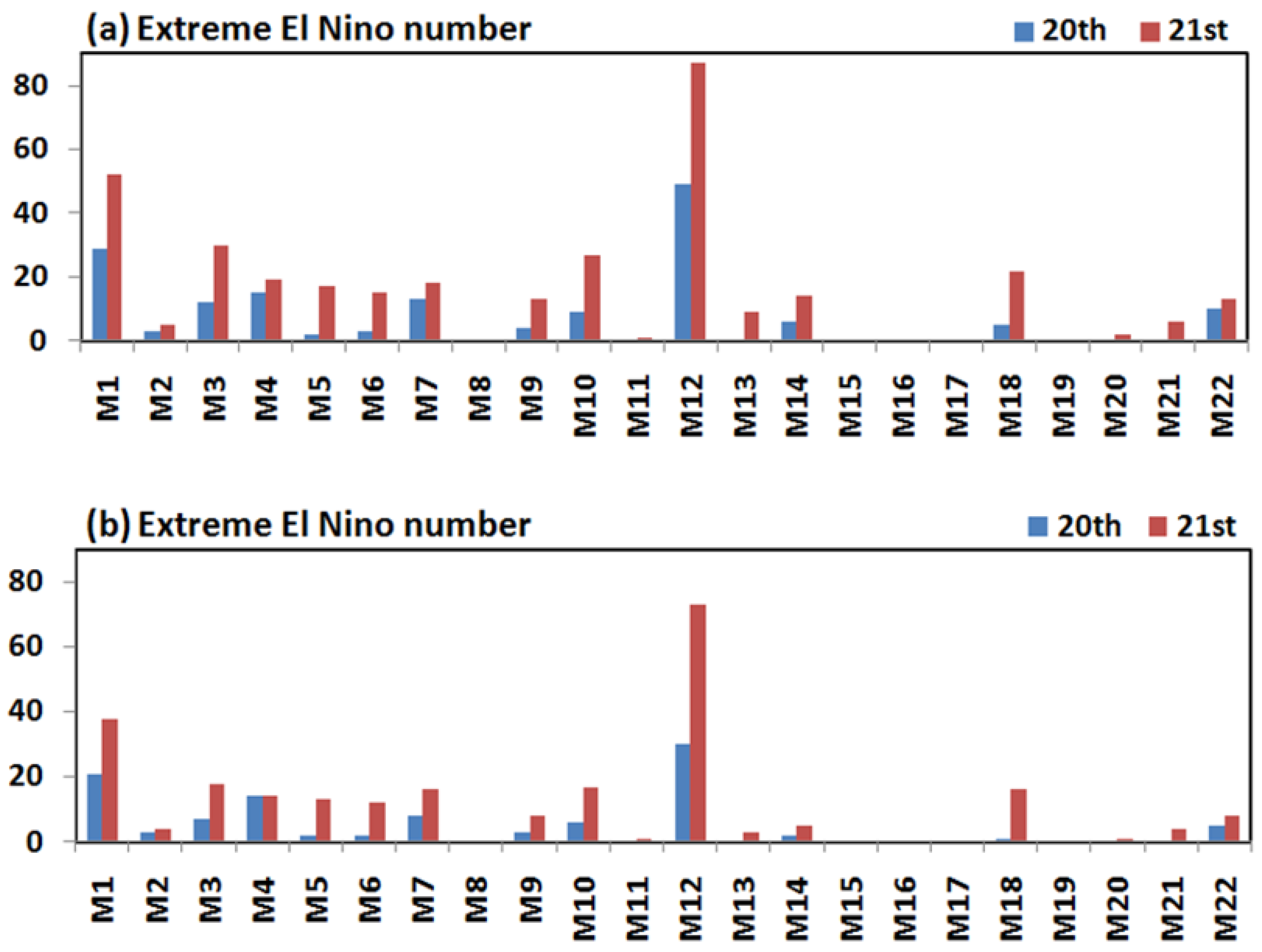
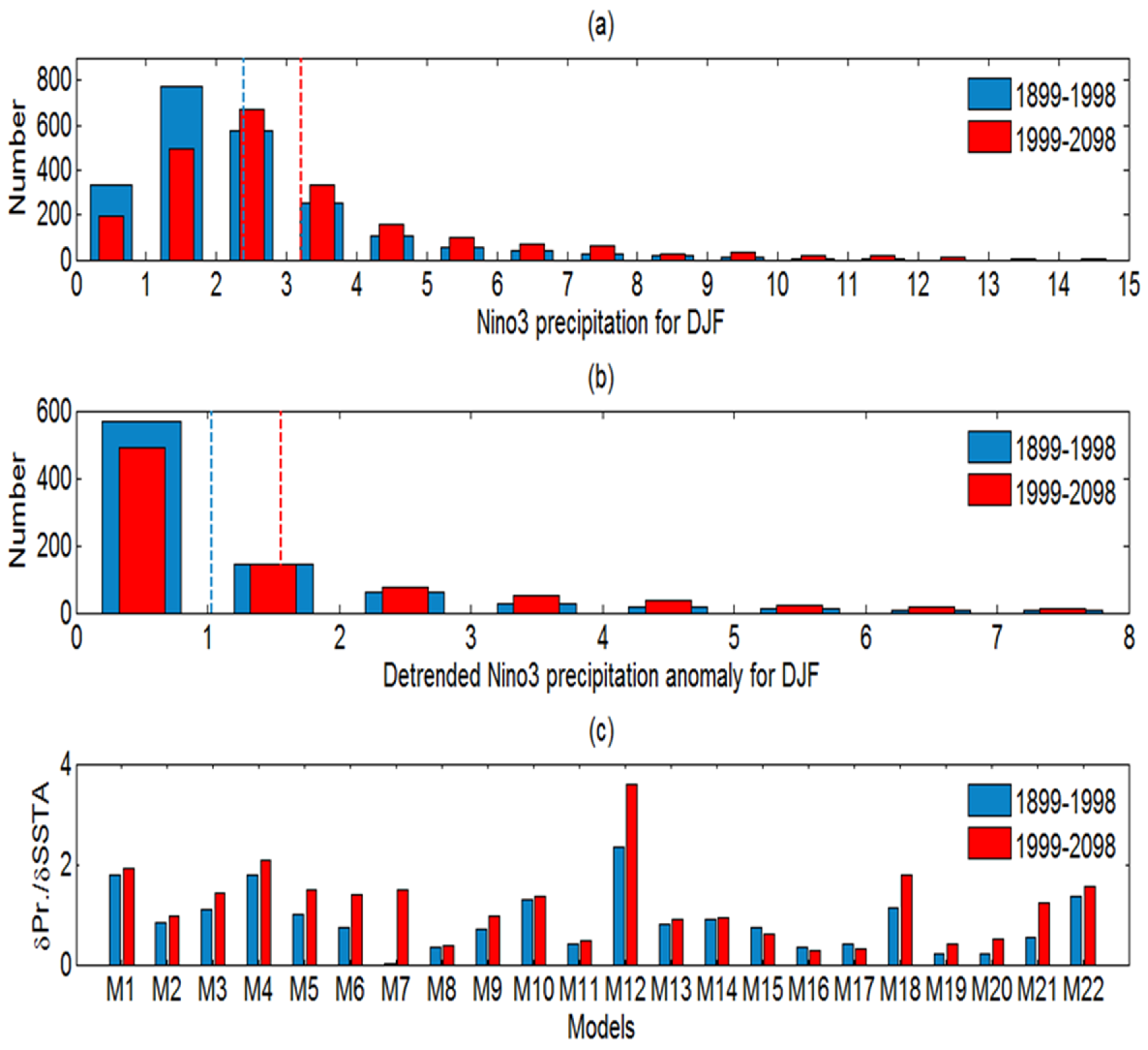
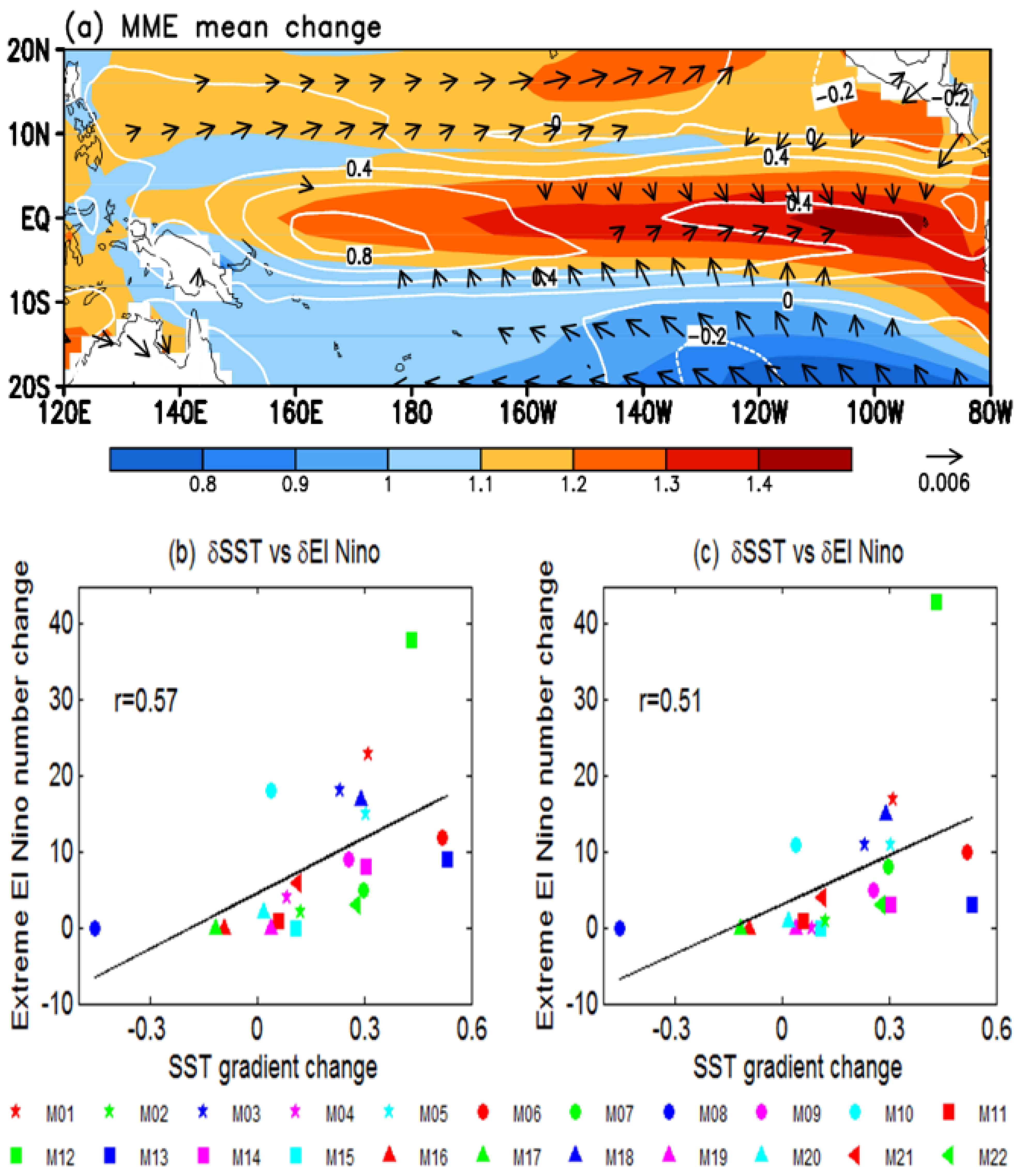
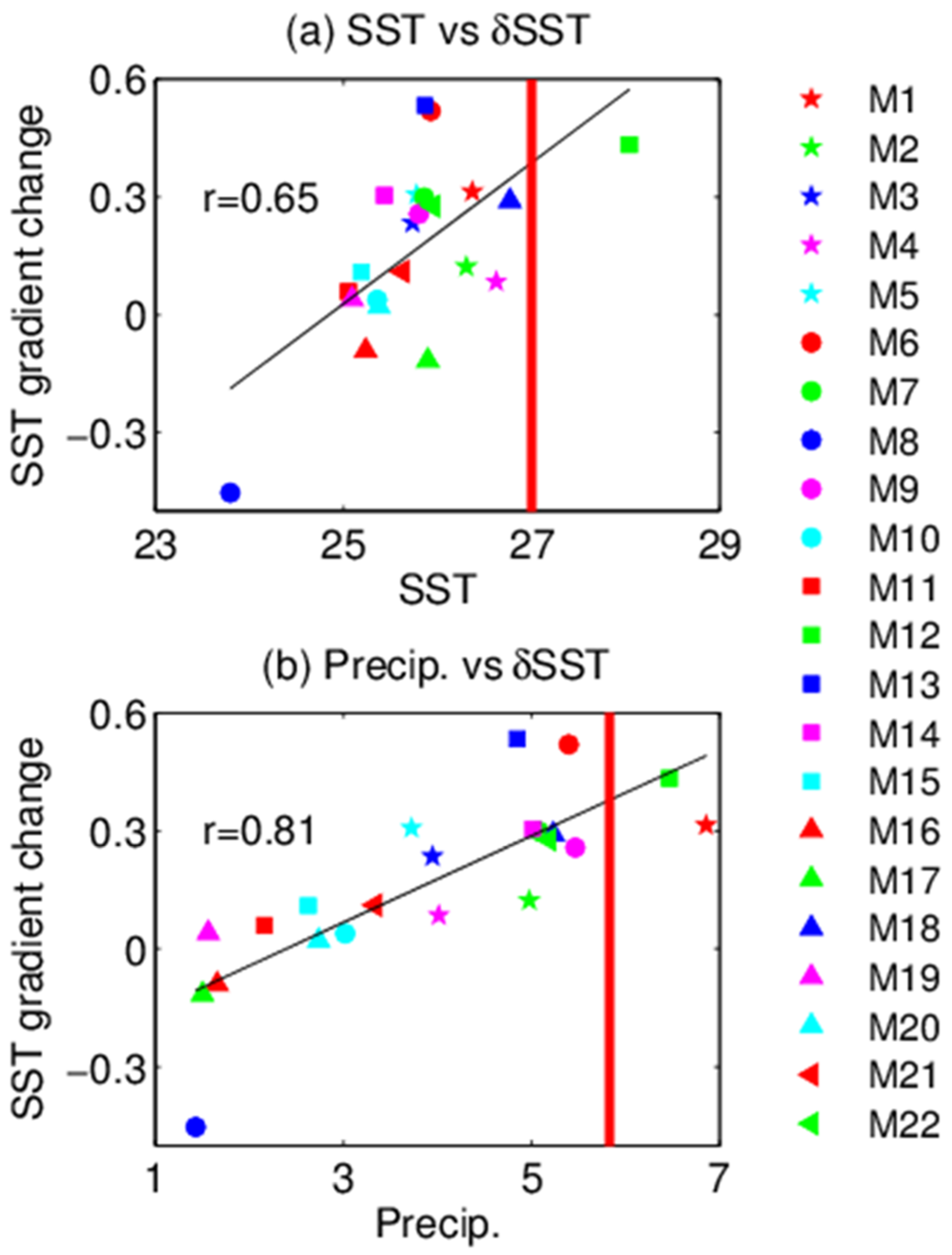
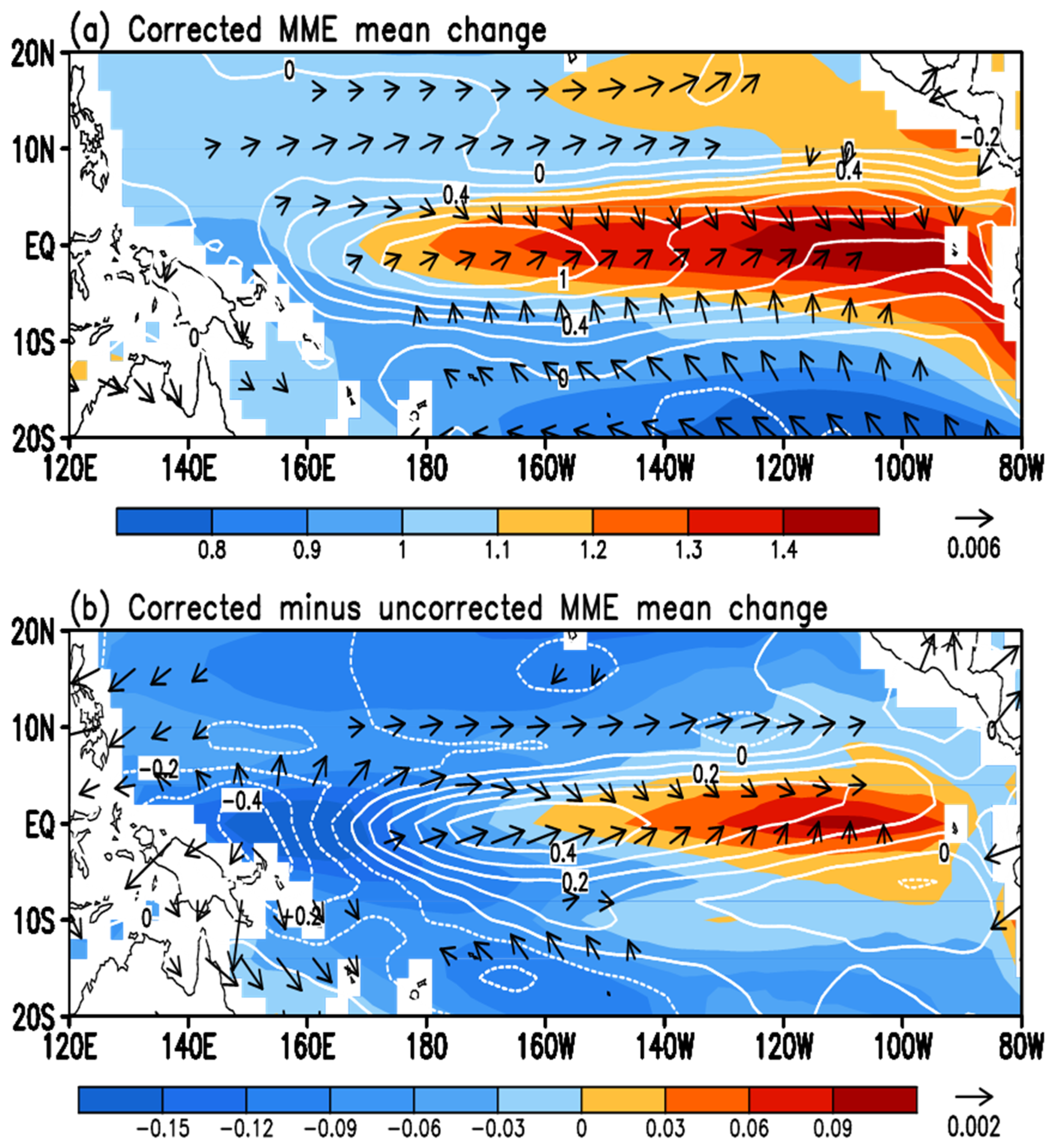

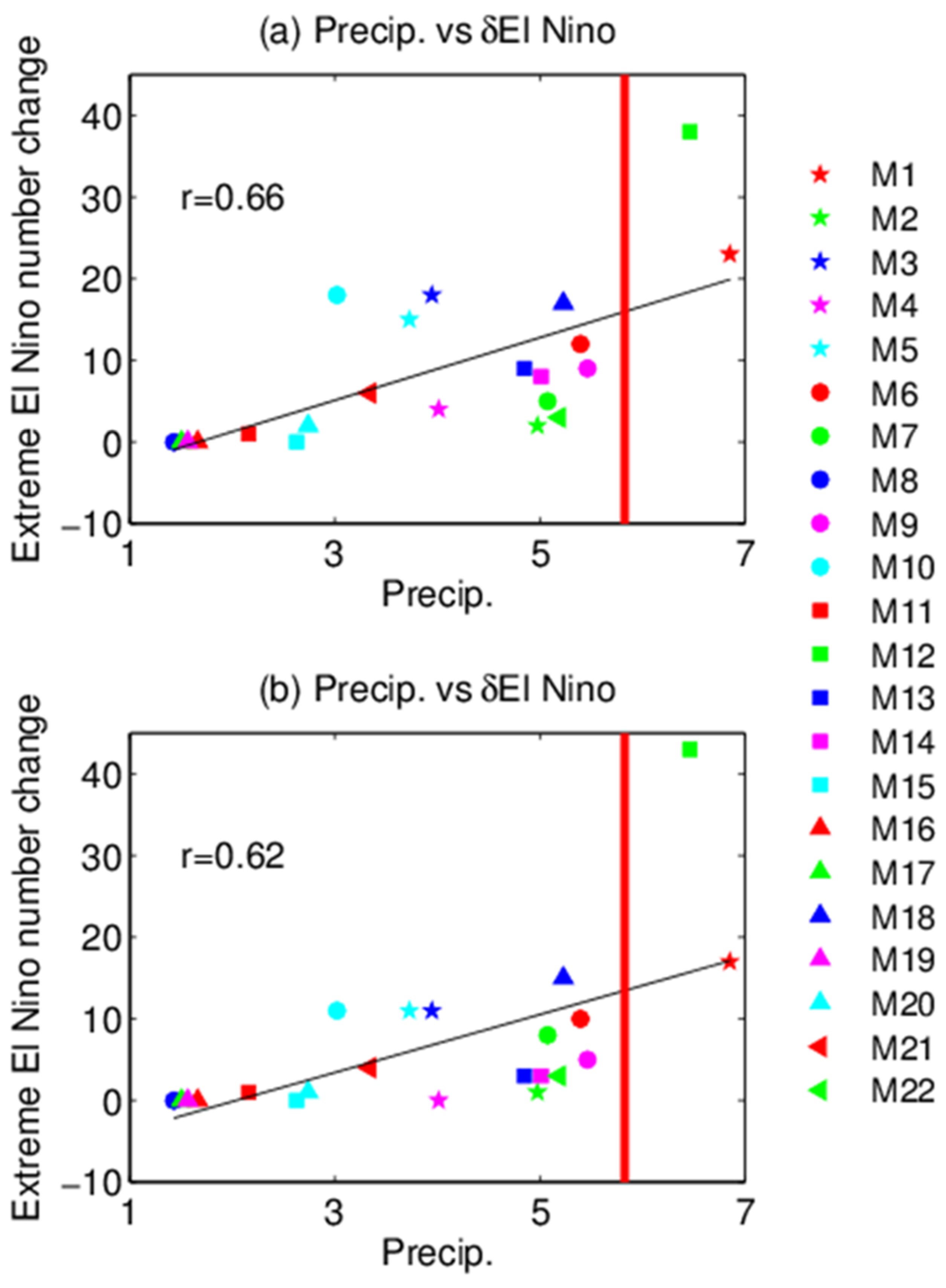
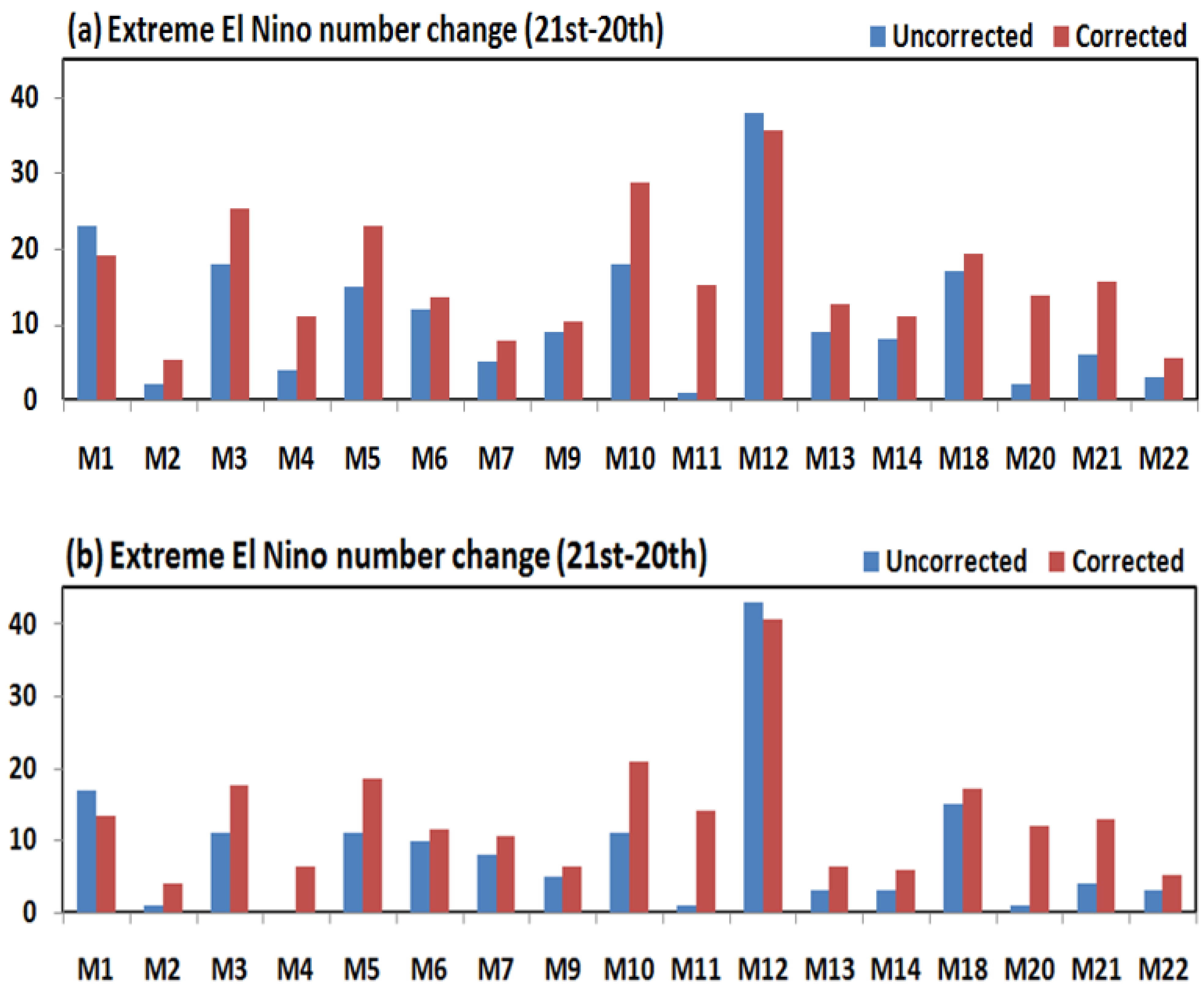
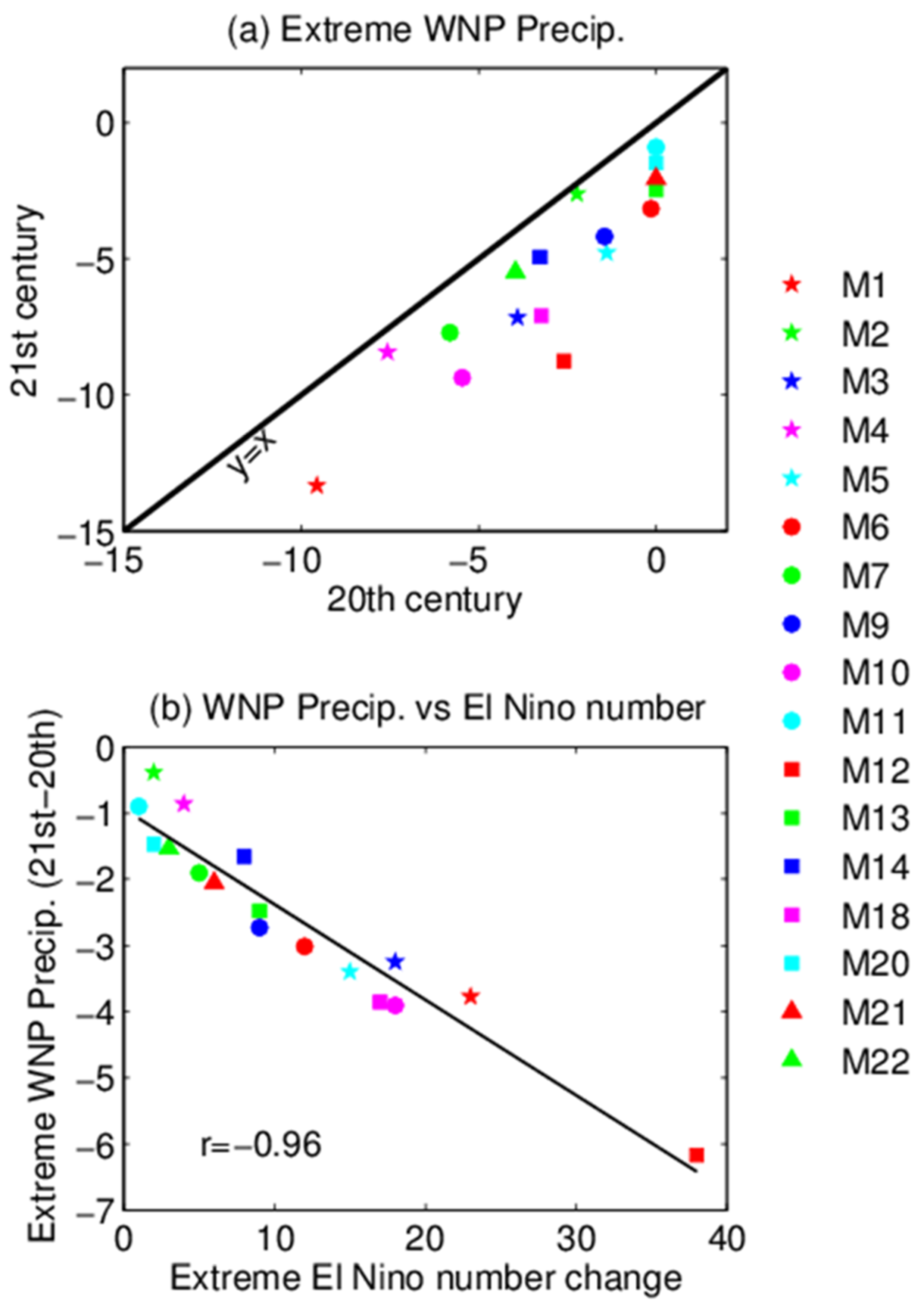
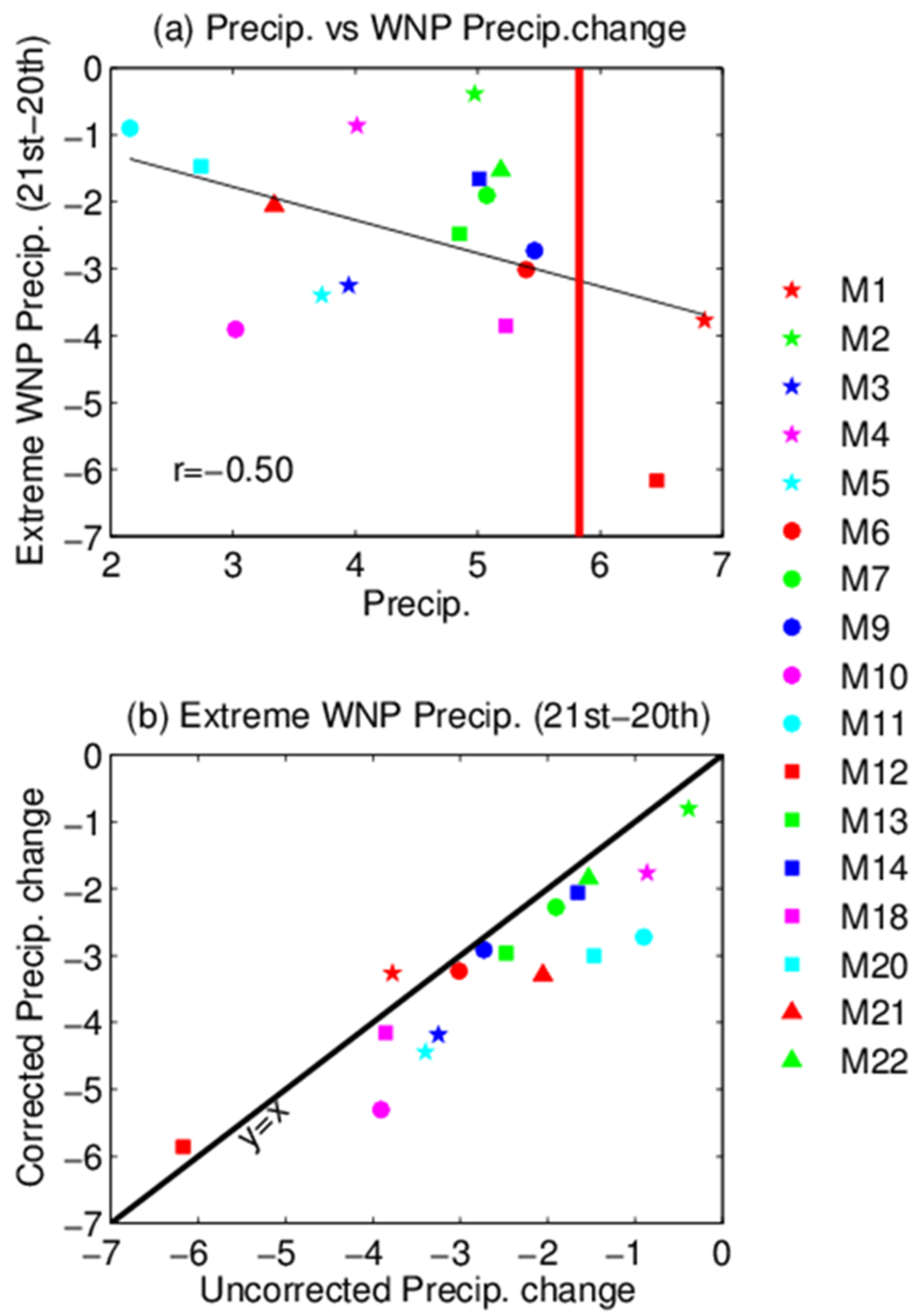
| Model Name | Model Group (or Center) | Letter Label |
|---|---|---|
| ACCESS1-0 | CSIRO-BOM | M1 |
| bcc-csm1-1-m | BCC | M2 |
| CanESM2 | CCCma | M3 |
| CCSM4 | NCAR | M4 |
| CESM1-CAM5 | NSF-DOE-NCAR | M5 |
| CMCC-CESM | CMCC | M6 |
| CNRM-CM5 | CNRM-CERFACS | M7 |
| CSIRO-Mk3-6-0 | CSIRO-QCCCE | M8 |
| FGOALS-s2 | LASG-IAP | M9 |
| GFDL-CM3 | NOAA GFDL | M10 |
| GFDL-ESM2G | NOAA GFDL | M11 |
| GISS-E2-R | NASA GISS | M12 |
| HadGEM2-AO | MOHC | M13 |
| HadGEM2-CC | MOHC | M14 |
| inmcm4 | INM | M15 |
| IPSL-CM5A-LR | IPSL | M16 |
| IPSL-CM5A-MR | IPSL | M17 |
| IPSL-CM5B-LR | IPSL | M18 |
| MPI-ESM-LR | MPI-M | M19 |
| MPI-ESM-MR | MPI-M | M20 |
| MRI-CGCM3 | MRI | M21 |
| NorESM1-ME | NCC | M22 |
Publisher’s Note: MDPI stays neutral with regard to jurisdictional claims in published maps and institutional affiliations. |
© 2021 by the authors. Licensee MDPI, Basel, Switzerland. This article is an open access article distributed under the terms and conditions of the Creative Commons Attribution (CC BY) license (https://creativecommons.org/licenses/by/4.0/).
Share and Cite
Li, G.; Zhang, Z.; Lu, B. Effects of Excessive Equatorial Cold Tongue Bias on the Projections of Tropical Pacific Climate Change. Part II: The Extreme El Niño Frequency in CMIP5 Multi-Model Ensemble. Atmosphere 2021, 12, 851. https://doi.org/10.3390/atmos12070851
Li G, Zhang Z, Lu B. Effects of Excessive Equatorial Cold Tongue Bias on the Projections of Tropical Pacific Climate Change. Part II: The Extreme El Niño Frequency in CMIP5 Multi-Model Ensemble. Atmosphere. 2021; 12(7):851. https://doi.org/10.3390/atmos12070851
Chicago/Turabian StyleLi, Gen, Zhiyuan Zhang, and Bo Lu. 2021. "Effects of Excessive Equatorial Cold Tongue Bias on the Projections of Tropical Pacific Climate Change. Part II: The Extreme El Niño Frequency in CMIP5 Multi-Model Ensemble" Atmosphere 12, no. 7: 851. https://doi.org/10.3390/atmos12070851
APA StyleLi, G., Zhang, Z., & Lu, B. (2021). Effects of Excessive Equatorial Cold Tongue Bias on the Projections of Tropical Pacific Climate Change. Part II: The Extreme El Niño Frequency in CMIP5 Multi-Model Ensemble. Atmosphere, 12(7), 851. https://doi.org/10.3390/atmos12070851







